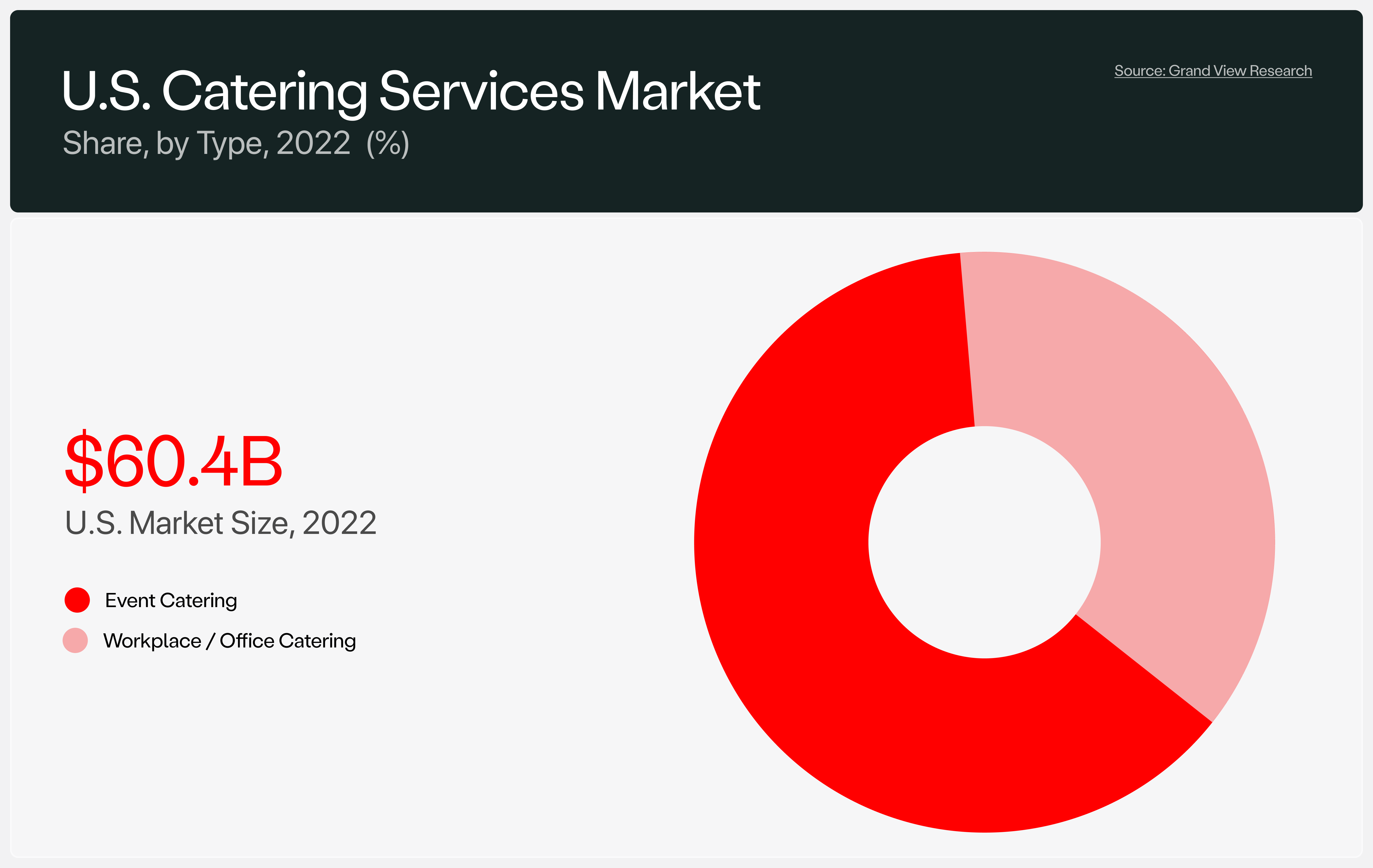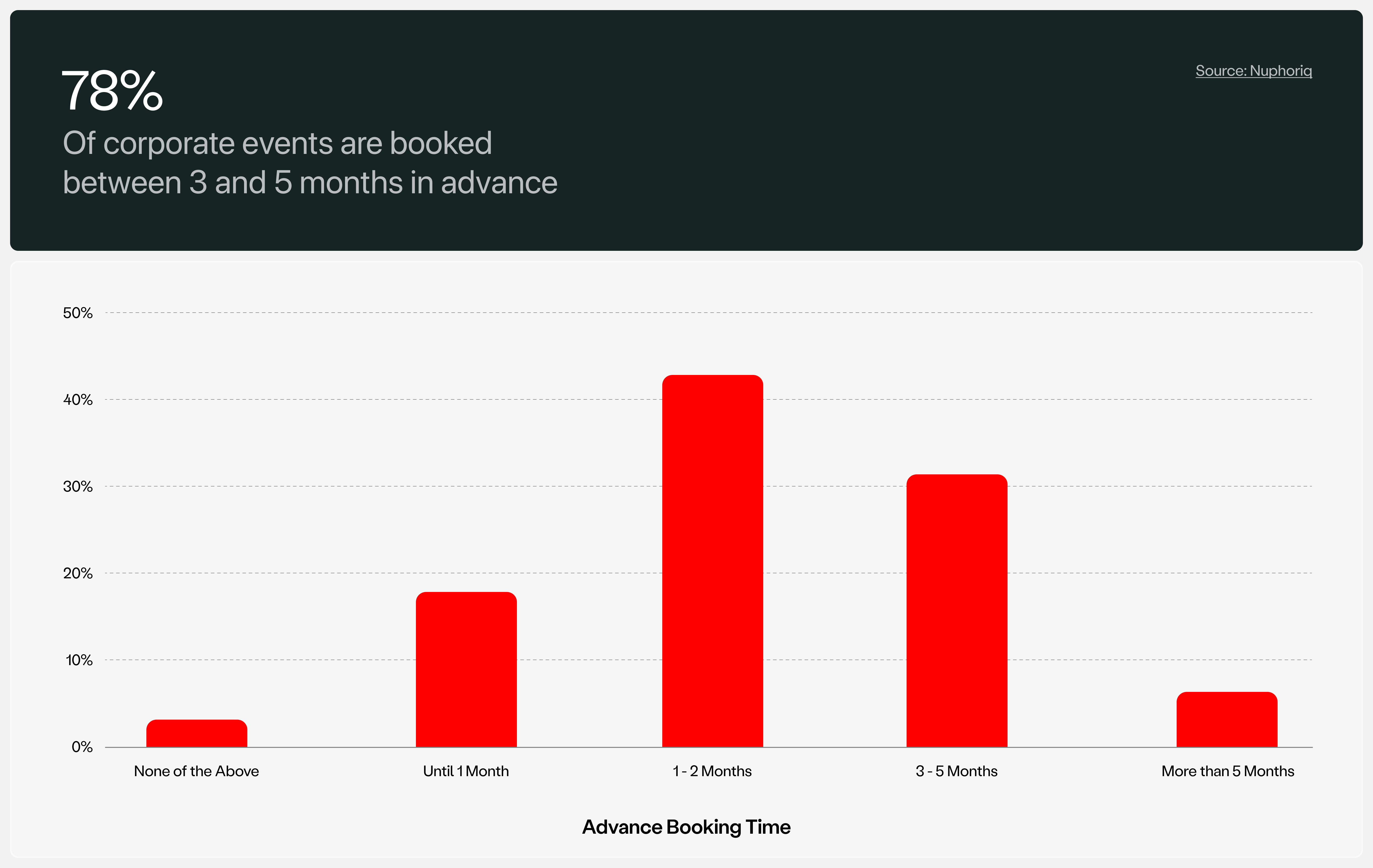Share
- Jump to:
In today’s catering landscape, reaching the right clients is crucial for long-term success. Knowing who to target and how to build relationships is key, from corporate meetings to large-scale events.
The catering industry is experiencing growth, with sales expected to reach $109 billion USD by 2032. There is a lucrative opportunity within B2B catering, which has experienced 34% growth over the past year. 48% of operators state that corporate events have been the largest driver of growth, and between 2024 and 2030, workplace/office catering is predicted to grow at a CAGR of 8.8%.
Ensuring your catering sales lists are targeted to the right B2B catering segments, localized to each store or metro, and integrated into your Marketing CRM will set you up for success and sales growth. Here’s a strategic guide to creating a high-performing catering sales list, incorporating data tools like Lunchbox Marketing CRM and industry-specific tactics.
Let’s talk about how to grow your catering sales.

Step 1: Identify Your Ideal Catering Clients
To build a well-targeted sales list, start by analyzing the local business landscape. Tools like Google Maps are invaluable for identifying potential clients in your area. Scrape Google Maps via a service, or hire a contractor through a platform like Upwork or Fiverr, to find nearby businesses and categorize them based on their size and industry. Hospitals, manufacturing plants, and warehouses—such as Amazon fulfillment centers—are often high-volume catering clients. Look for other business types with high concentrations in your area, whether they’re corporate offices, schools, or small local businesses.
By building a group of target categories, you can focus your efforts on sectors with the highest catering potential. For example, a hospital might need regular catering for staff, while corporate offices may want catering for meetings and events.
Actionable Tips:
Plan Ahead: Focus on large, recurring opportunities, like weekly staff meals or special events, and tailor your menu offerings to meet the needs of these specific sectors. If targeting sports teams, look for the game calendar and plan to reach out a month in advance.
Tailor Marketing & Implement SEO: Once identified, create customized landing pages and optimize them to appear in Google searches. Use headlines like “Healthy Sports Catering in (CITY NAME)” and “Catering for Business Meetings.”
Make Updates: Add catering as a service to your Google Business Profile and route guests to your first-party catering platform. This way, you will show up in searches for “catering near me” and own your guest data as new orders come through. Also, ensure you have a landing page on your website to showcase your catering services—here is an excellent example from Maman.
With that in mind, make sure you plan months ahead, canvass the area for events and opportunities, reach out, and build relationships—studies show that 78% of large corporate events are booked between 3 and 5 months in advance.

(Nuphoriq)
Step 2: Use AI Tools to Scrape Contact Information
Once you’ve identified key business segments, the next step is to gather contact information. AI-powered tools like Seamless AI or ZoomInfo can help you scrape LinkedIn and other platforms for valuable contact details within the businesses you’ve identified. Focus on reaching out to decision-makers in specific roles for each business type:
Hospitals: Office managers, administrative assistants, HR departments.
Manufacturing plants & warehouses: Operations managers, facility managers, procurement teams.
Corporate offices: Executive assistants, event planners, HR.
Schools: Administrators, PTA heads, and coordinators for events.
Local businesses: Owners or general managers.
Sports teams & fundraisers: Event coordinators, sponsorship managers.
Actionable Tips:
Build and Segment: Prioritize building a robust list of contacts from LinkedIn and business directories. Segment them by industry and role so your messaging can be targeted and relevant.
Remove Manual Work: Use a service like Seamless AI to scrape emails and build a list for you. Tools like this also come with a Chrome Extension, which makes pulling data on one-off LinkedIn profiles easier.
Upload to a CRM: Investing in a powerful catering solution with a built-in CRM, like Lunchbox Catering, can help you automate marketing sequences and create a data-driven profile on each guest and segment. The platform also integrates with HubSpot, which can be a helpful tool in managing leads.
Step 3: Build Relationships with Key Decision-Makers
Having contact information is just the beginning; the real value lies in building strong relationships with decision-makers. Once you’ve made initial contact, offer exclusive incentives or rewards to the individuals placing catering orders. Personal touches, such as handwritten thank-you notes or complimentary items, go a long way in building rapport.
For follow-ups, aim for consistency without being overly aggressive. Set a schedule for regular communication, such as reaching out monthly to check on upcoming events or offering promotions. Take it one step further by being proactive and checking their website regularly for upcoming events and activations. Ensure your follow-ups are value-driven, with tips or ideas to help the recipient plan better events or reduce their catering costs.
Actionable Tips:
Make it fun: How can your brand stand out from the competition and offer a unique and personalized experience?
Look for referrals: Chances are one of the parents at the sports game has more than one kid who might be enrolled in other sports. Look for business expansion opportunities within your events, and come ready with flyers.
Train your in-store staff: Leverage your in-store staff to be on the lookout for logos, parents, sports uniforms, and more. Train them to recognize opportunities when they walk through the door and mention catering. Offering store staff an incentive like a percentage of sales is a great incentive.
Reward the Orderer: Reward repeat customers with loyalty perks, such as a gift card for the person who regularly places the order. Make sure to acknowledge their role in choosing your catering service.
Step 4: Leverage Data from Existing Customers
Your current customers provide a wealth of information to guide your sales strategy. Analyze your historical catering data to understand which industries and businesses generate the most revenue. Are certain sectors more likely to reorder? What events or time frames show a spike in demand? Use this data to focus your efforts on similar businesses.
Additionally, find opportunities to upsell or cross-sell based on your clients’ preferences. For instance, if a corporate office regularly orders lunch, market to them for catering breakfast and push promos on seasonal menu items. Large corporation? Check to see if they host company-wide conferences and holiday parties and if they have offices in other cities where you have a presence.
Actionable Tip: Use analytics from Lunchbox Marketing CRM to track key data points like order frequency, menu items ordered, and average spend. This will help you identify high-value clients likely to generate repeat business, and what on your catering menu is performing well with guests.
Step 5: Continuously Refine and Update Your List
Your catering sales list should evolve as your business grows. Regularly clean your list by removing outdated or inactive contacts, and keep adding new prospects from your networking efforts, events, or marketing campaigns. Refine your outreach strategy by tracking the success of your messaging and campaigns. Identify which segments yield the best results and adjust your efforts accordingly.
Actionable Tips:
Regular Maintenance: Schedule quarterly reviews of your sales list to ensure it’s current. Use reporting tools to measure engagement and identify the most profitable customer segments.
Automate List Cleanup: Use email cleaning software to remove old and inactive email addresses from your list. This will ensure you are given accurate email metrics to measure success.
Conclusion
Building a targeted catering sales list is a multi-step process that involves research, data analysis, and relationship-building. By leveraging tools like Seamless AI to scrape contacts, integrating your insights with Lunchbox Marketing CRM, and continuously refining your list, you can create a dynamic, high-converting sales list that drives both new business and repeat customers. With thoughtful targeting and personalized follow-ups, your catering business will be well-positioned for long-term growth.